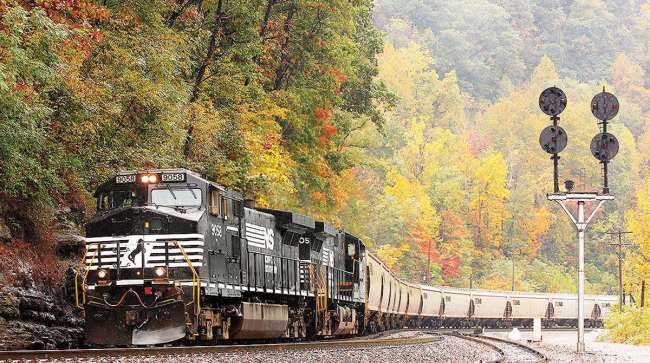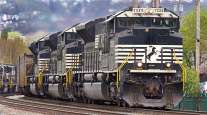Senior Reporter
Norfolk Southern Reports Record Q3 Results

[Stay on top of transportation news: Get TTNews in your inbox.]
Atlanta-based Class I railroad Norfolk Southern reported record third-quarter results on Oct. 27, exceeding Wall Street’s expectations, even as railroad officials said freight growth is being hampered by supply chain disruptions at seaports, intermodal facilities and in trucking.
Norfolk Southern reached quarterly high marks for revenue, profits and operating ratio even as company official said traffic volume was flat, they are running short of train crews and the slow pace of hiring new employees is having an impact on the railroad’s service levels.
Net income rose 17% to $753 million, or $3.06 a share, compared with $569 million, $2.22, last year.
The Zack’s consensus estimate of transportation experts was $2.89 a share.
Revenue was up 14% to $2.85 billion compared with $2.5 billion in 2020.
The railroad’s operating ratio was 60.2, a third-quarter record, compared with 66.5.
Operating ratio measures a company’s operating expenses as a percentage of revenue and determines efficiency. The lower the ratio the more ability the company has to make a profit.
“Our third-quarter results reflect a strong performance from the team as we delivered third-quarter records for operating ratio, net income, income from railway operations and earnings per share. While volume held steady with last year, revenue grew an impressive 14% and our 60.2 operating ratio reflects a 230-point improvement on a year-over-year adjusted basis,” CEO James Squires said on a conference call with analysts and reporters. “In the midst of significant supply chain disruptions and labor shortages across the country, we’re delivering upon our commitments.”

Squires
Company officials said with the supply chain in disarray, warehouse capacity at record low levels, a truck driver shortage of at least 80,000, the railroad industry having difficulty hiring employees, a chassis shortage and terminal congestion, it’s unlikely things will improve until well into 2022.
“Unprecedented demand from inventory restocking and consumer spending outpaced available capacity in the supply chain ecosystem,” Chief Marketing Officer Alan Shaw said. “The combination of drayage shortages, warehouse productivity, equipment availability, labor force participation and rail network fluidity pressured intermodal volume throughout the quarter.”
Norfolk Southern said to meet the demand it is adding 1,100 leased chassis in the fourth quarter, as well as adding more container and storage areas, as well as expanding terminal capacity.
“Despite hiring all year long, attrition has been accelerating in each of the last two quarters in several of those critical areas,” Chief Operating Officer Cynthia Sanborn said. “Some of the things we are doing to create relief: we’ve more than tripled our conductor trainee rank since the first quarter so that we can effectively backfill in critical areas; we’ve implemented tools such as perfect attendance bonuses, referral bonuses and signing incentives to improve the stickiness of our current and future workforce; and we continue to leverage the valuable Go Teams to quickly respond to business opportunities where needed.”
Norfolk Southern did add more than 1,000 employees during the quarter bringing its employee head count to 21,232 compared with 20,086 a year ago.

Research shows that 41% of technicians leave the industry within the first two years. Host Michael Freeze asks, how can technician recruiters and maintenance leaders decrease that percentage? We talked with Ana Salcido of Navistar and Stacy Earnhardt of TMC. Hear a snippet above, and get the full program by going to RoadSigns.TTNews.com.
Across the railroad’s various business lines revenue was up in all of the sectors with the exception of one, automotive. In that area, all of the Class I railroads reported quarterly drops in automotive revenue because of the worldwide shortage of computer chips and other auto parts.
Automotive revenue declined 19% to $218 million from $270 million a year ago.
Agriculture, forest and consumer products increased 8% to $564 million from $521 million.
Chemicals increased 18% to $504 million from $428 million in 2020.
Metals and construction increased to $424 million from $337 million.
Merchandise shipments jumped 10% to $1.71 billion from $1.55 billion.
Intermodal items moved upward 16% to $812 million from $700 million.
Coal shipments soared 32% to $330 million from $250 million and quarterly coal tonnage deliveries were up 7% year-over-year.
All of the major railroads have seen a steep increase in coal because of the need for the product not only in the U.S., but also China and India because of a worldwide energy shortage, especially when it comes to producing electric power.
“Coal, grain and other single commodity unit trains offer real opportunity for gains through collaborating with our customers on operating trains with more cars per set and by doubling up existing trains over portions of their route. I expect we will show continued progress in the fourth quarter as we see the fruits of our effort,” Sanborn said.
Want more news? Listen to today's daily briefing below or go here for more info:




